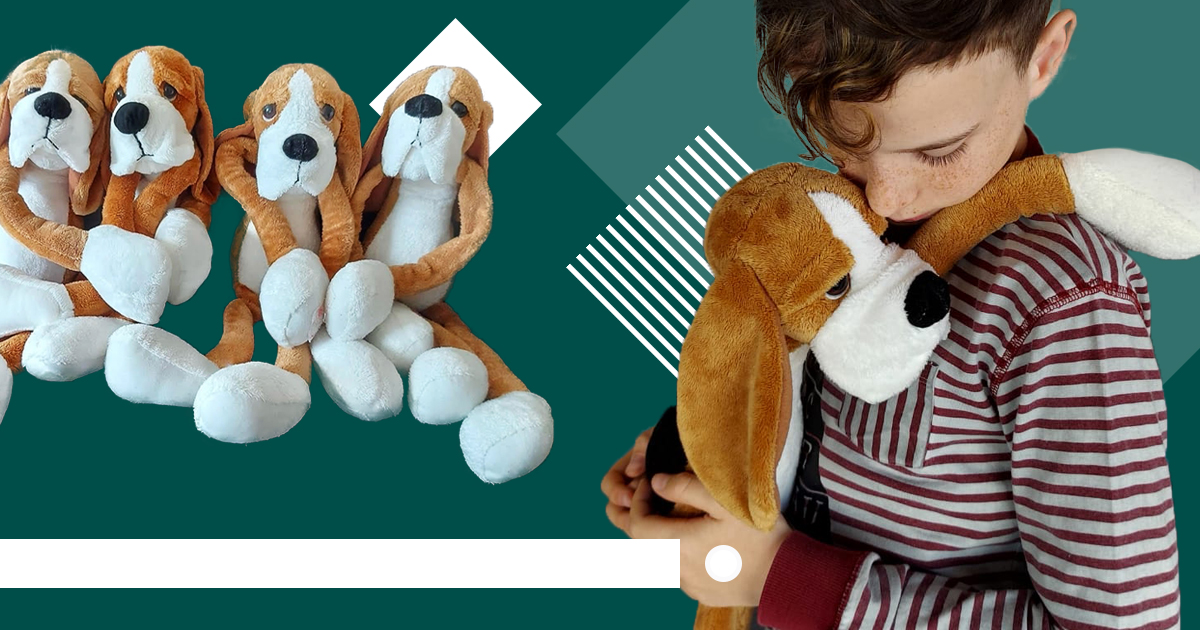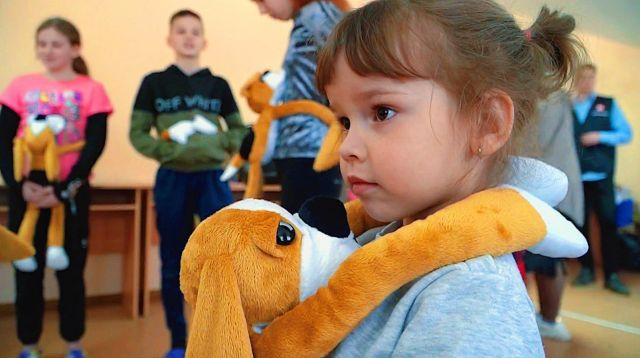The method invented in Israel is now used by psychologists in Ukraine. Rubryka talked to them about how an ordinary toy with long legs and ears can help children survive war and trauma.


In the difficult times Ukraine is experiencing, our children lack communication and positive emotions. But not only that, today, millions of young Ukrainians are traumatized by the war. According to UNICEF, 3 million children in Ukraine and more than 2.2 million children in refugee-hosting countries have been affected by the full-scale invasion in the past three months alone.


Hugs are one of the most amazing and affordable things to soothe a child. Psychologists have been talking about the healing power of hugs for a long time. Hugs reduce stress, improve mood, relax the body and nervous system, and give a feeling of protection, care, love, and understanding. Who can help a child get the hugs they need now? Of course, loving relatives. And there's the wonderful Hibuki hug dog, a unique therapeutic toy that helps you survive the trauma and cope with the pain, loss, and destruction caused by russian military aggression.
The Hibuki dog came to us from Israel to comfort and hug as many Ukrainian children as possible. Candidate of psychological sciences, art therapist Tetyana Dzyuba, the regional head of the Hibuki-therapy project in Poltava, told Rubryka about the peculiarities of the technique.
Hibuki means "hug" in Hebrew. This toy can hug. And the Hibuki dog knows how to listen without interrupting. It can wipe tears from the eyes with its long velvety ears. Can become someone who comforts and understands. The therapeutic method of working with children's trauma, Hibuki therapy, is new in Ukraine, but in Israel, children have been successfully helped with this method since 2006.
The creator of Hibuki therapy was Dr. Shai Hen-Gal during the Second Lebanon War in Israel. Since then, Hibuki has helped children in Israel, Japan, and America to overcome trauma, recover mental health, and return to life. Now, thanks to Daphne Sharon-Maksymova, a psychotherapist, an international expert in crisis and trauma work, and a training trainer in Hibuki therapy for Ukrainian psychologists, the project is already working in all regions of Ukraine. Every day, more and more Ukrainian children can receive Hibuki's comforting hugs, which stay with the child forever because, during the therapy, the helper toy is given to the child (of course, parents or guardians do not need to pay for this).
As Tetyana Dzyuba said, Hibuki therapy is a process in which a psychologist, using a specially developed technique, gradually and carefully enters the therapy together with the child, helping them cope with the trauma of the war.
Hibuki is not just a dog with sad eyes. This is a toy model, the details of which are carefully thought out and balanced. Hibuki's size is perfect – like a newborn baby, and it's no accident. Because in this way, it is easy for the child to hug and feel protected.
Hibuki is soft to the touch. Touching the toy, the child feels warmth, comfort, and security.
Another secret of Hibuki is sad eyes. And it's not accidental, either. According to the method's author, Dr. Shai Heng Gal, and the manager and author of the project adaptation idea, Dafna Sharon-Maximova, a child looking into Hibuki's eyes, transfers their fears and worries to the toy, learns to understand themself, take care of themself and others, and be sensitive. This transfer of a traumatic experience from a child to a toy helps them cope with psychological trauma and not get stuck in it.
When children talk about Hibuki, they tell their stories, which is therapy's biggest secret. Psychologists must tell parents about this to better understand and help their child overcome the trauma of the war through interaction with the toy at home.
"I remember the story of a girl whose family left Kharkiv. During the individual work, we got to know Hibuki: we played games, made up stories, told secrets, and drew a portrait of Hibuki," says Tatiana Dzyuba.
"The child was happy that she had a new friend. But in the evening, already at home, the girl told her mother that the dog was very sad and she should not look at a sad dog. "Let's return it tomorrow," she suggested to her mother.
This story shows that the child is not talking about the dog but about their feelings, trying in this way to tell about what they feel now. At this moment, it is so important for parents to understand and react to it correctly. It is necessary to talk with the child about the reasons for such a condition, listen to them, and help them cope with their own helplessness. This is how the child experiences new attitudes, understanding of their conditions and needs, and most importantly, the ability to take care of themself."
Children from 4 to 14 years old with the following signs of trauma can become project participants:
A soft and, at first glance, clumsy long-legged dog is like an ordinary soft toy, but as the psychologists working on this project note, Hibuki's hug dog "can dry children's tears, heals the soul and gives back the ability to smile and enjoy life." The child, together with the psychologist and Hibuki friend, gently and carefully goes through all the stages of psycho-emotional recovery.
The psychologist gets to know the child (necessarily in the presence of one of the parents or a person who replaces the parents). Introduces the child to Hibuki (for a child, it is a toy, for adults, it is a therapeutic tool). If the child accepts the toy, it is possible to establish contact, then the child receives Hibuki for free. Adults receive recommendations on how to interact with a child through a toy. Important — the toy is provided individually; it cannot be bought and sold afterward.
An equally important task of the project is training highly qualified psychologists-therapists acquainted with the Hibuki therapy method. The basic format is an online course taught by experienced psychologists who have experience working with trauma and psychologists who have successfully used the Hibuki therapy toy in their practice.
One of the project's important tasks was adapting the methodology directly to the realities of the Ukrainian war. Ukrainian psychologists could not simply copy the method of the Israeli toy. An important aspect of the project realization is its adaptation and implementation, taking into account Ukraine's mental and cultural characteristics.
Firstly, it is the duration of the war, the prolongation of trauma at all levels of "child-family." Secondly, the traumatic experience of the psychologist-therapist themself, who provides assistance. The project manager made such an adaptation of the tool – this is how the method turned from a one-time intervention into a therapy.
Complementary to the Hibuki therapy method is art therapy tools that allow you to gently and gradually work with war trauma, integrating all levels of perception: bodily, emotional, and then, under conditions of stabilization of states, meaningful. This process of "body-emotion-meaning" stabilization is essential to avoid problems of retraumatization (repeated trauma) and additional psycho-emotional shifts.
The project is in constant motion and development. New data appears. Currently, the generalization of the obtained results of the project is in progress — and this is already more than 1,500 specific cases and stories.
"While observing children during individual and group meetings, I, as a psychologist, noticed various manifestations of childhood trauma. But the child's first acquaintance with Hibuki becomes a whole big story for them:
She adds that Hibuki has helped many children deal with anxiety, fear, nightmares, and anxiety caused by sirens.
Qualified psychologists are currently working in many cities of Ukraine and beyond, where psychotherapeutic assistance centers have been set up for people who were forced to leave their homes due to the war. If you know someone who needs the help of a gentle Hibuki dog or wants to participate in the project, contact the regional representatives. They will be able to help every child! The list of regional project managers can be found at this link.
The United Help Ukraine Charitable Fund of America became the sponsor of the project. This organization launched a campaign to raise funds for producing and distributing 6,100 Hibuki therapy dogs for Ukrainian refugee children and displaced persons with signs of traumatic stress related to the war in Ukraine. UHU is currently collaborating with its Israeli partners to train therapists, doctors, teachers, and other volunteers in Ukraine to use the Hibuki intervention.
More than 260 volunteer Ukrainian psychologists have been trained in Ukraine. The first batch of 1,100 Hibuki puppies has already been distributed — the majority through 19 treatment centers across Ukraine to children from the most affected fighting areas, including Mariupol, Bucha, Gostomel, Kharkiv, and Odesa.
The project has an excellent partner in Lviv — the company TAKA MAKA, a Ukrainian board games manufacturer. Yaroslav Boychuk, the head of the company, came to the project himself and offered his help in developing and creating a book with the history of Hibuki for his little friends.
In general, a hug dog has two books in Ukraine. The first is a small comic book in Hibuki's pocket, which is located on the toy's tummy (by the way, this idea of the little boy Shai from Israel was also embodied in the Ukrainian version of Hibuki). The second book also has bright illustrations and is intended for those who can already read. This book describes Hibuki's story: who he is, where he came from, what he loves, what he feels, and how he can share it with a child.
The project was supported by the Ukrainian toy manufacturer Macik (Dnipro). Since the beginning of the project, 1,600 Hibuki dogs, already adapted to the needs of Ukrainian children, have been sewn and given to the children of Ukraine. And this is important because the realities of the war would not allow waiting for many months of bureaucratic permits if the toy was imported exclusively from abroad.
The Hibuki-therapy project continues! From the beginning of September, a new stage of project implementation started, and 5,000 children in Ukraine will hug their new friends with slightly sad eyes. And the pain will not be so piercing, and the fear will not be so terrible. The childhood trauma of this dreadful war is relieved because there is a friend to hug.
Проєкт психосоціальної реабілітації дітей Recovery Camp працює вже три роки і за цей час отримав… Читати більше
Екологічна освіта, громадянська наука та цікава практика — складники ініціативи, яку втілили для молоді Краснокутської… Читати більше
A team of researchers has trained an AI model to see not just rubble in… Читати більше
У лікарнях Харкова та Ужгорода студенти під наставництвом психологинь, менторів та супервізора проводять для дітей… Читати більше
У Лубнах фахівці, які допомагають військовим, вчилися будувати довірливий контакт із тваринами, зокрема кіньми та… Читати більше
Фізика — це про дослідження себе й світу. Саме так вважає Христина Гнатенко, українська науковиця… Читати більше
Цей сайт використовує Cookies.